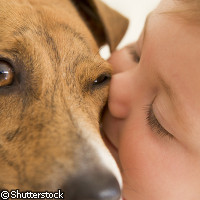Three-year-old children get the point
EU-funded researchers in Hungary have found that pet dogs and two-year-old humans, who experience similar home environments, also interpret adults' pointing gestures in a similar way. Three-year-old humans, on the other hand, are able to interpret a wider range of pointing gestures and use the direction in which the index finger is pointing to find a hidden object. The findings, published in the journal Animal Cognition, are an outcome of the 'Origins of referential communication' project, which was financed through the 'New and emerging science and technology' Thematic area of the Sixth Framework Programme (FP6). Previous research has shown that domesticated dogs can interpret a range of human communication signals, including eye movements and head turning. While dogs do not receive the complex linguistic training that human infants do, their owners are likely to speak with them in a form of 'motherese' or baby talk. Also, they may have evolved to interpret certain human signals that consistently lead to a reward. Human infants, on the other hand, receive extensive linguistic training from their carers, and learn to use the pointing gesture (with index finger) themselves at around the age of 14 months. Before then, however, children will often stare at the pointing finger itself, rather than at the distant target the adult is indicating. Between the ages of two and three years, the ability of children to communicate both verbally and with gestures changes rapidly. In the current study, Professor Gabriella Lakatos of Eötvös University in Budapest, Hungary, and her team took a closer look at how children of two and three years and dogs would respond to a range of pointing actions. They focused specifically on the ability of each group to interpret unfamiliar pointing gestures based on a generalised understanding of pointing. The researchers carried out two studies, one on pointing gestures with the arm and another on pointing with the leg. The 15 dogs and 13 2-year-olds went through the protocol in their homes to remove the stress of an unfamiliar environment, while the 11 3-year-olds were tested in their nursery school. In both studies, two flower pots were placed about a metre apart and a reward (a snack or favourite toy) was placed in one of them. Then, the researcher would use one of four gestures to point at the pot with the reward. The two-year-olds and dogs responded correctly to fewer gestures than the three-year-olds, but responded consistently to the direction of a protruding body part. Three-year-olds responded successfully to the direction of the pointing index finger. So if the person pointing stood with her arm across her chest, elbow protruding to the left and finger pointing to the right, the three-year-old child would follow the finger, but the two-year-old child and the dog would follow the elbow. With leg gestures, again the three-year-old children responded correctly for all four gestures, including pointing with just the knee, while the two-year-olds and dogs responded correctly only to the foot-pointing gestures. The authors believe that the results of the leg-pointing study suggest that the subjects were able to generalise from their previous experience to a relatively novel directional gesture. By the time children are two to three years old, the researchers say, 'marked changes have taken place in their capacity to utilise visual communicative signals'. Also, there are differences in the ability of the two age groups to cooperate with adults, which would certainly have an impact on the toddlers' understanding of gestures. Additionally, the authors believe that interactions during language learning 'facilitate the understanding in children that the index finger has the important role of indicating objects of interest even over long distances'. The lack of linguistic training in dogs, they say, could also explain why their canine subjects could not overcome this hurdle. 'The subjects' responsiveness to the variations of the pointing gesture suggests that both dogs and children (of both ages) have the ability to use rules to generalise from the pointing gesture to other similar types of gestures,' the study concludes. 'Three-year-olds seem to recognise the index finger as a general directional signal. In younger children, protruding body parts provide the main cue for deducing directionality. At least at the functional level, dogs show a similar performance as two-year-olds, that can be explained as a joint outcome of their evolutionary history and their socialisation in a human environment.'
Countries
Hungary



